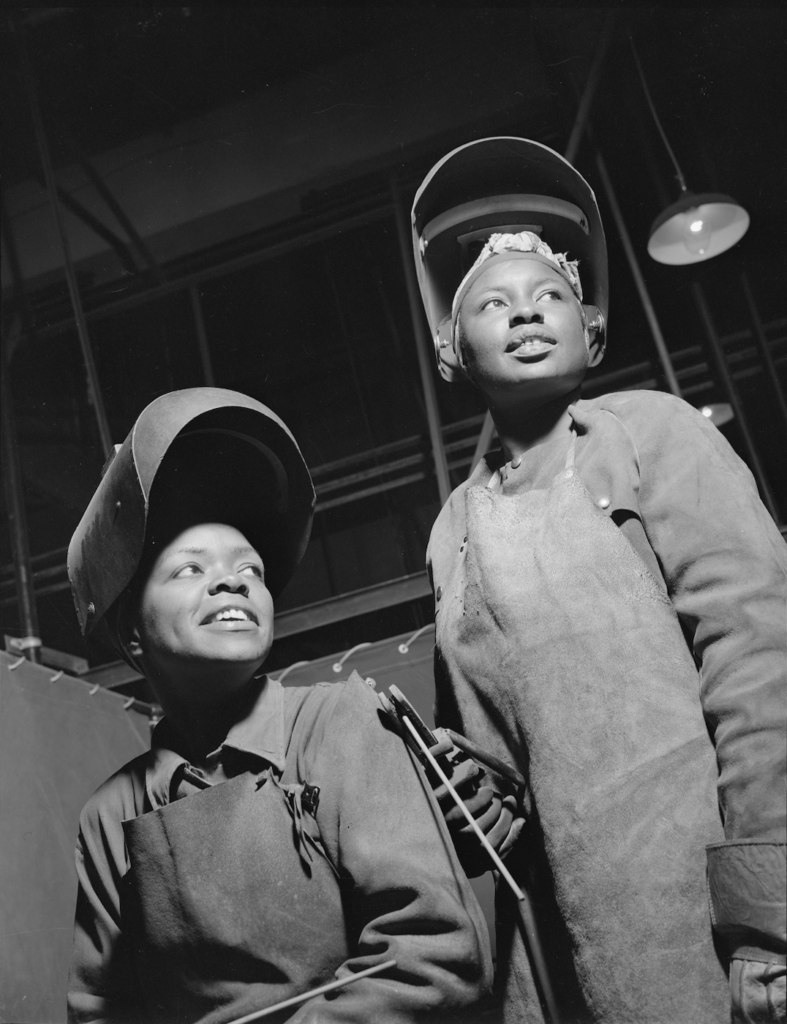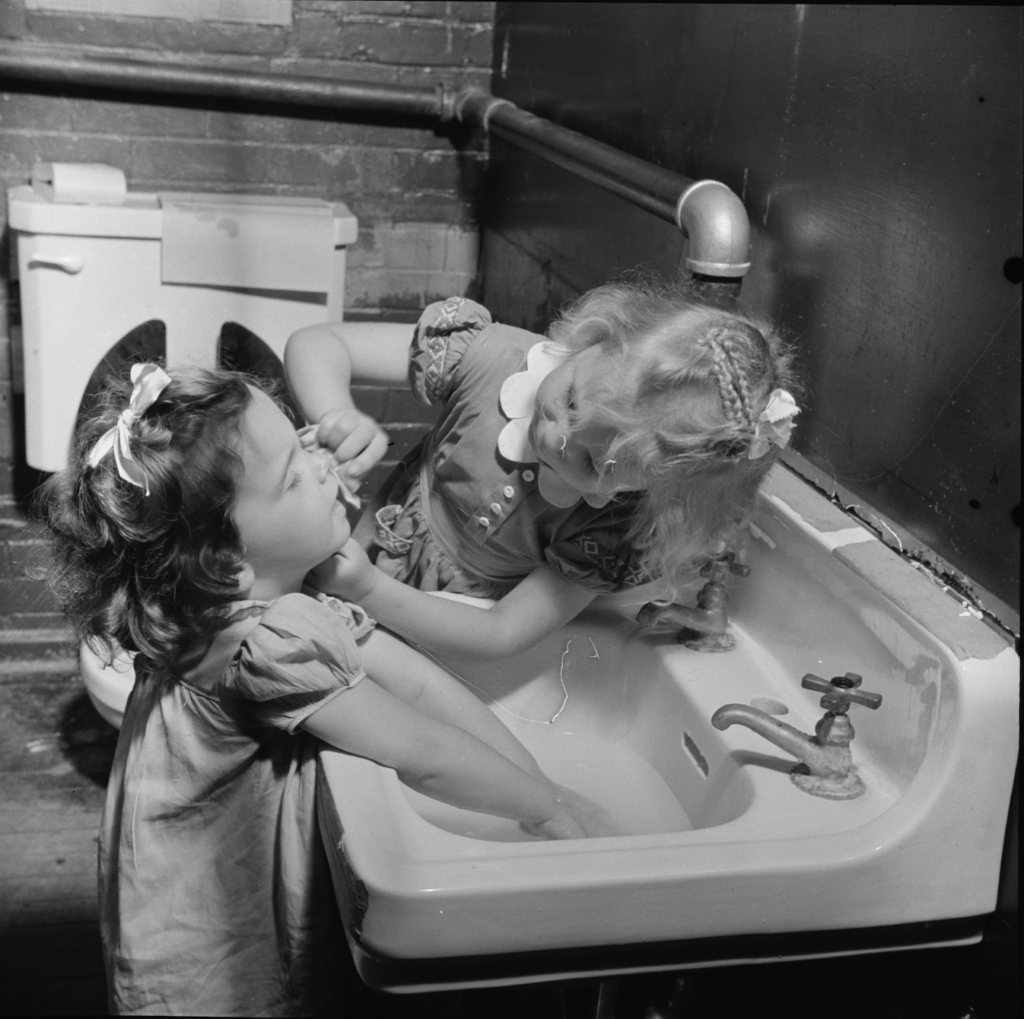
“Pumpkin pies and Thanksgiving dinner at the home of Mr. Timothy Levy Crouch, a Rogerine Quaker living in Ledyard, Connecticut,” November 1940. photo: Jack Delano
By Mary M. Donohue and Elizabeth J. Normen
(c) Connecticut Explored Inc. Summer 2022
Subscribe/Buy the Issue!
All images are courtesy of the Farm Security Administration – Office of War Information Photograph Collection, Library of Congress.
The Crouch family of Ledyard, Connecticut sat down to a traditional turkey dinner with pie for dessert on November 21, 1940, blissfully unaware that in a little more than a year the country would be at war. Jack Delano, the federally-employed photographer who documented the event, had spent that fall traveling around the state recording the small towns, farm families, and factory workers that made up Connecticut. His photographs, along with other photographers who documented Connecticut on behalf of the Farm Security Administration and the Office of War Information (FSA-OWI), created an important record of life in Connecticut between 1935 and 1944.
The FSA, historian Briann Greenfield wrote in A Life of the Land: Connecticut’s Jewish Farmers (Jewish Historical Society of Greater Hartford, 2010), was “primarily a relief agency created [in 1935]by the federal government to assist poor farmers during the Dust Bowl and the Great Depression with loans, government aid, and resettlement projects. But the agency also included a photographic division devoted to recording the agency’s history and with it the history of the rural communities it served. With the coming of World War II, the FSA’s photographic division was transferred to the Office of War Information [in 1942].”
Here we offer examples of work done by and short biographies of three FSA-OWI photographers: Jack Delano, Marion Post, and Gordon Parks. FSA-OWI photographers were encouraged to caption their images, and many of these provide important details. Each image is accompanied by the caption as provided by the photographer.
Jack Delano
Jack Delano (1914 – 1997) was born Jacob Ovcharov in 1914 in what is now Ukraine. He emigrated to Philadelphia in 1923 and, as Alan Bisbort notes in a profile in The Hartford Courant (February 27, 2014), “took the name ‘Jack’ from boxer Jack Dempsey and ‘Delano’ from a schoolmate.” He studied at the Pennsylvania Academy of Fine Arts and in 1936 began to use photography in his art. Delano was “interested in people not only as images, but also as human beings,” he later wrote in Three Photographers in Depression-Era New Mexico (Museum of New Mexico Press, 1994). He photographed Connecticut in 1940 and 1942. His farm images reveal his sensitivity to immigrants and the working class. He also captured urban images of Norwich and of the state’s factories soon to be pressed into World War II production, including Vought-Sikorsky Aircraft in Stratford, Farrell Birmingham Foundry in Ansonia, and textile mills such as Ponemah Mills in Taftville.
According to the 1940 census, at the time of the photo above, farmer-turned-stonecutter Timothy Crouch (1879 – 1949) was living in a rented house with his wife and eight children. “In this innovative shot,” Bisbort noted, Delano “echo[ed]the famous painting by Norman Rockwell [of]about the same time, Freedom From Want.”

“At a loom in the [Ponemah] Mills, Taftville, Connecticut. Makers of cotton and rayon cloths,” 1940. photo: Jack Delano
Delano did not record the young woman’s name. Ponemah Mills, located in Taftville in Norwich, was one of Connecticut’s largest textile mills, with 4,000 looms in the 1920s, according to John Nolan’s History of Taftville, Connecticut (The Bulletin Press, 1940).
Marion Post
New Jersey-born Marion Post is best known for her FSA-OWI photographs produced between 1938 and 1942, according to the Library of Congress. After her parents’ divorce when she was young, she attended a progressive boarding school in Greenwich and grew up immersed in the bohemian New York art world of her artist mother. She paid her own way through New York University by providing childcare and teaching nursery school in Connecticut. She and her sister studied in Vienna, where she took up photography, until World War II approached. Back in New York, she continued to pursue photography and met photographers Paul Strand and Ralph Steiner. Struggling in the late 1930s, she landed a job as a staff photographer for the Philadelphia Evening Bulletin. Her position there was so unusual the newspaper included her in its feature story “Strange Jobs for Women” in 1939. Bored of the “women’s beat” to which she was assigned, she was recommended for the FSA position by Strand and Steiner. Her marriage to Lee Wolcott in 1941 effectively ended her career, though she received renewed recognition for her photography later in life, including a New York gallery exhibition in 1975.
Post visited Connecticut in May and June 1941. She photographed housing conditions for war workers, traffic congestion and shift changes at Pratt & Whitney in East Hartford and Electric Boat in Groton, tobacco farming, and women and children.

“Frank Robbins of Wareham, Massachusetts, employed at United Aircraft, East Hartford, Connecticut, lives in trailer near the plant, with wife and four children because of housing shortage. He works nights, so he can sleep days in a bed used at night by two of the children. He makes forty dollars a week, his trailer payment is twenty dollars per month and twelve dollars rent for the campsite,” June 1941. photo: Marion Post

“Rolfe Lawrence Chickering, farmboy from Saint Johnsbury, Vermont, who came to work at Pratt and Whitney United Aircraft in January 1941. Because of congested housing conditions, he commutes twenty miles each way daily from East Hartford to Suffield Connecticut, where he lives with a private family, pays eight dollars weekly for room and board. He is single, about twenty years old.” photo: Marion Post
Gordon Parks
Kansas-born Gordon Parks, who became one of America’s most distinguished photographers (among other talents), began his career with a one-year fellowship with the FSA in 1942 – 1943. According to a Library of Congress biography despite having received encouragement from FSA photographer Jack Delano, as a Black man Parks was only accepted into the program under pressure from the Julius Rosenwald Fund, which had underwritten the fellowship. According to the Gordon Parks Foundation, Parks went from the OWI to work with the Standard Oil Company on a photo documentary project and as a freelancer for Glamour and Ebonymagazines. He gained widespread acclaim in 1948 for a photo essay about a Harlem gang leader, which led to his becoming the first African American staff photographer for Life, where he remained for two decades.
Parks visited New Britain in May and June 1943. He photographed war-time factory work, child-care centers, and street scenes. Captions often noted the nationalities of his subjects, including Lithuanian, Polish, Polish-American, Irish-German, and German-American, the work they were doing, along with the subject’s age and, for women, how many children they had.

“New Britain, Connecticut. Women welders at the Landers, Frary, and Clark plant,” June 1943.
photo: Gordon Parks
Though Parks did not record these women’s names, another photo is captioned “New Britain, Connecticut. Barney Mason, Negro, employed at the Fafnir Bearing Company for twenty-six years, is now superintendent of the forging division,” suggesting the range of employment possible for African Americans in New Britain’s factories in wartime.

New Britain, Connecticut. A child care center opened September 15, 1942, for thirty children, ages two through five of mothers engaged in war industry. The hours are 6:30 a.m. to 6 p.m. six days per week. Washing up for lunch.” June 1943. photo: Gordon Parks
Federally-subsidized day care was established in 1942 in cities and towns contributing to defense production, according to “Who Took Care of Rosie the Riveter’s Kids?” (The Atlantic, November 18, 2015)—“the first, and, to date, only time in American history parents could send their children to federally-subsidized childcare, regardless of income.”
Mary Donohue is assistant publisher of Connecticut Explored. Elizabeth J. Normen is the founding publisher of Connecticut Explored.
GO TO NEXT STORY
GO BACK TO SUMMER 2022 CONTENTS
